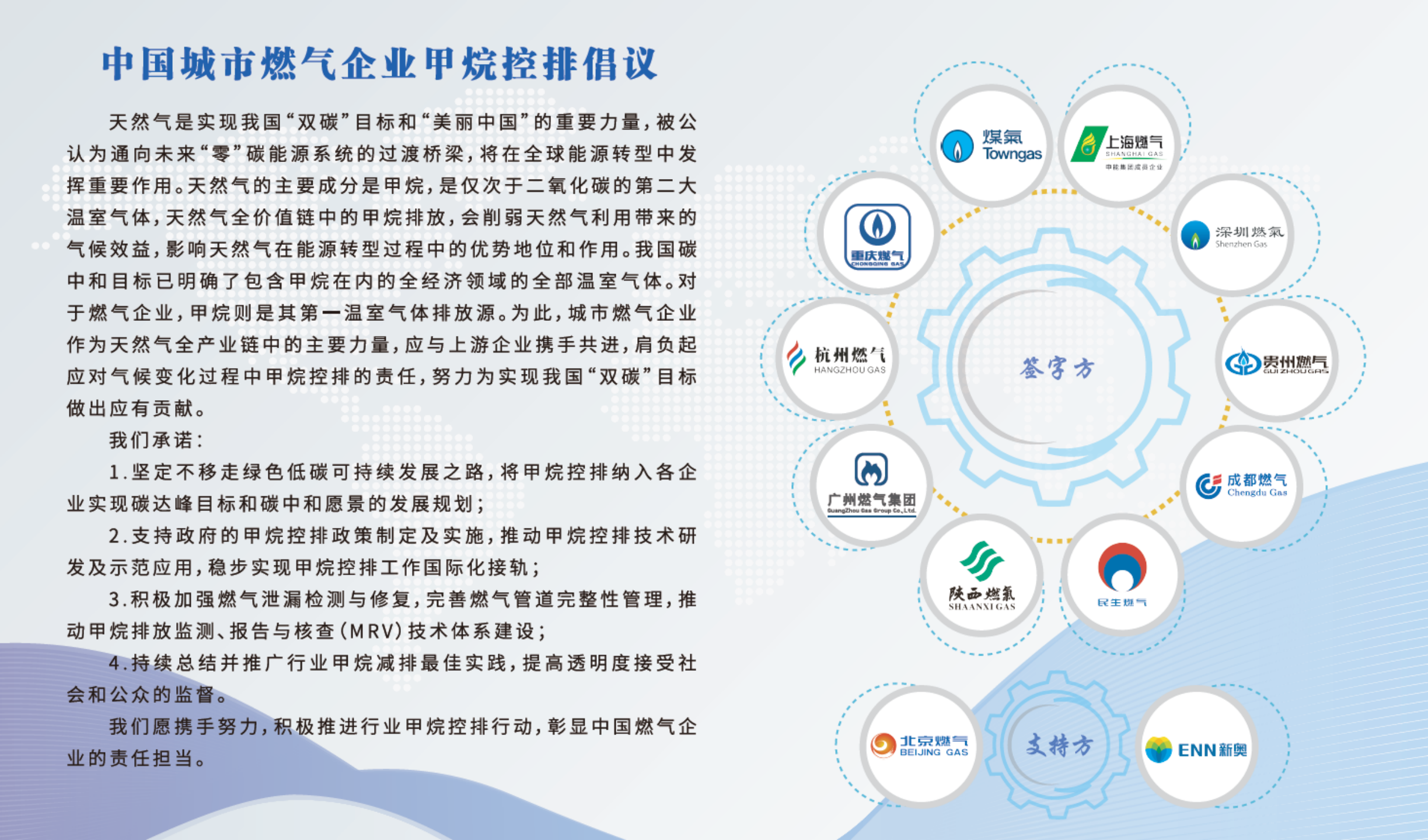
ENN Energy Holdings Limited is committed to environmental sustainability. By identifying the risks and opportunities posed by climate change, we take timely responses to adapt or mitigate the impact of climate change on business.
ENN Energy formulated the ENN Energy’s Climate Change Policy, which clarifies the company’s climate change targets and risk response. It is used as the basis to respond to climate risks, take advantage of the opportunities arising from climate change, and contribute to the mitigation of global climate issues.
The ESG Committee maintains oversight over climate change-related issues, regularly discusses and monitors climate risks through actions including:
1. Identifying the company’s climate risks and opportunities of climate, assessing the thus to set climate goals;
2. Assessing the impact of potential extreme weather and natural disasters on gas transmission and distribution, pipeline network storage, transportation, and safety, and formulating timely response strategies.
To guarantee the effectiveness of climate risk management and governance, the company incorporates performance indicators of climate risk management into management's remuneration with appropriate implementation and supervision of related activities through the establishment of a management team dedicated to climate change response.
Climate Stategy
Following the guidance of climate change management framework, ENN Energy has developed relevant business strategies to mitigate potential climate risks, while seizing opportunities of low-carbon transformation and benefiting the cooperation with stakeholders. We forwardly work with the government to carry out “goal-to-gas” and promote zero-carbon energy development. Solar energy, geothermal energy, biomass energy, and hydrogen are developed as the green energy business.
limate Risk Identification and Response
With preliminary review and analysis of the climate risk levels of operation area, we have identified significant climate-related matters that have had or are likely to have impacts on ENN Energy, and have formed risk identification results by region (see pages 13-15 of the ENN Energy 2020 ESG Report for details).
In 2020, we had identified the transition risks and physical risks related to climate change, and finally formulate corresponding countermeasures. At the same time, we have referred to the Climate-Related Financial Disclosure Task Force (TCFD) framework to disclose climate-related governance, risks, strategies and objectives.
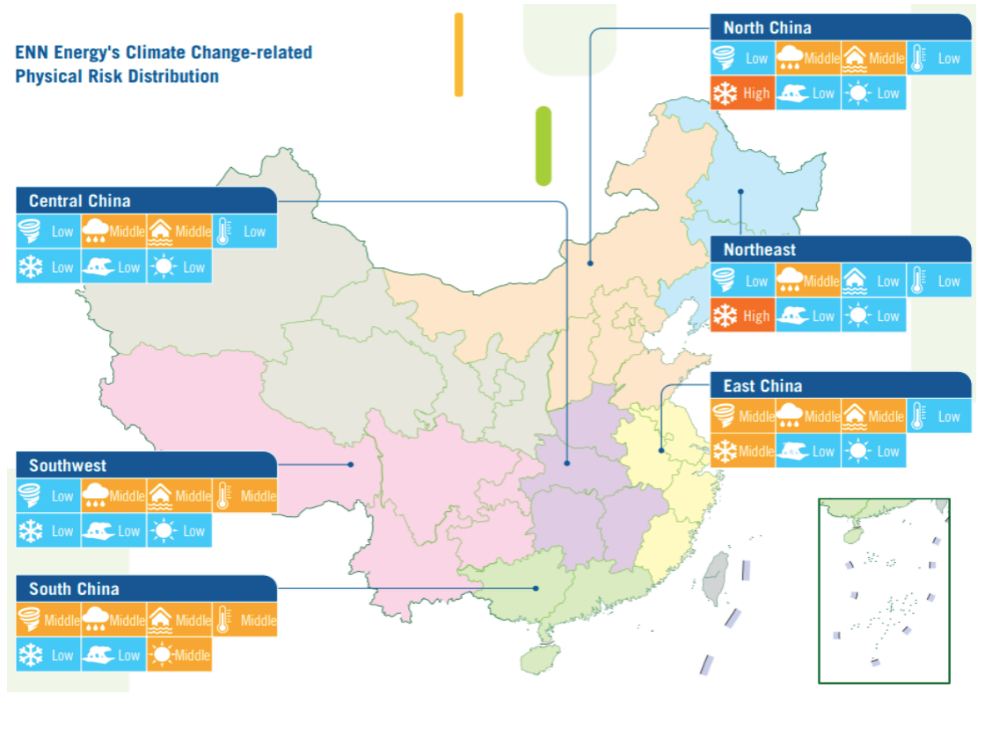
Physical Risk | Impact | Response | |
Acute Risks | Typhoon | The operation pipeline network, equipment and facilities may be damaged, affecting the stability of gas supply, threatening the safety of employees and customers, and resulting in compensation and legal liabilities for breach of contract due to business interruptions and other issues | · We formulated a typhoon emergency rescue plan; · Used stronger facilities and pipes, and constructed a ring-shaped pipe network to effectively avoid one point destruction causing the overall destruction of the natural gas pipeline network; and · Constructed facilities near to the end user, such as heightened flood defences to improve resistance against natural disasters. |
Extreme Precipitation | The operation pipeline network, equipment and facilities may be damaged, affecting the stability of gas supply, threatening the safety of employees and customers. The risk of flooding of gas supply facilities in low-lying areas may increase. | · We formulated emergency rescue plans for flooding and lightning; · Adopted more robust facilities and pipes; · Increased interconnectedness the urban management information platform to realise the sharing of data and resources. This improves the timeliness of information acquisition, reduces the chance of pipeline damage, realises real time monitoring of third party operations along the pipeline network, provides safety risks alerts promptly, and thus enhances the pipeline network operational safety; · Designed and built a looped pipeline network to effectively avoid the overall damage of the natural gas pipeline network caused by a point damage; · Constructed a ring-shaped pipe network to effectively avoid one point destruction causing the overall destruction of the natural gas pipeline network; and · Constructed facilities near the end user, heightened flood defenses to improve resistance against natural disasters. | |
Flood | |||
Extremely Hot Weather | The health and safety risks of employees, the operating costs of temperature control in the stations, and the maintenance costs of gas supply facilities may increase. | · We formulated an emergency rescue plan for heat stroke. | |
Extremely Cold Weather | The health and safety risks of employees, the operating costs of temperature control in the stations, and the maintenance costs of gas supply facilities may increase. | · Implemented safety risk prevention and control measures for employees to protect their safety under extremely cold weather; and · Established winter gas supply working groups in each member company to insure gas supply for customers. The working groups will carry out temperature forecasting, monitoring, analysing and reporting of changes in resource supply and demand, as well as reviewing and updating their responses so as to actively prepare gas sources in advance to ensure stable supply. | |
Chronic Risks | Sea level Rise | Existing operating pipeline network and equipment and facilities may be damaged, and existing market may be affected due to migration of cities from coastal regions to inland. | · We continuously monitor the trends of sea level rise; and · Research relevant loss prevention and emergency plans. |
Global Warming | The risk of heat waves, droughts and fires may increase the maintenance costs of gas supply facilities. The energy consumption of gas supply facilities in the winter may decline. | · We formulated an emergency plan for extreme environments and an emergency rescue plan for heat stroke. | |
Transition Risks | Risks and Opportunities | Responses |
Risks and Opportunities Align with Transition Risks | In the future, the national energy structure will shift to non-fossil fuel energy. We are responding to the national energy policy by vigorously developing our integrated energy business, adjusting the proportion of renewable energy in the current business to better respond to market demand, and providing downstream customers with more diversified green and low-carbon energy solutions. | · Promoted the use and research and development of new and renewable energy sources, and expand the utilization of renewable energy sources such as solar energy, geothermal resources, and biomass in the pan-energy ecosystem; · Cooperated with local governments to continuously promote the optimization of energy structure, multi-energy complementarity and "coal to gas" policies. |
Objectives of Climate Change Management
In accordance with our medium- to long-term decarbonisation plan, we formulated emission reduction targets for city gas business and integrated energy business respectively.
Business Sector | Short-term (2025) | Medium-term (2030) | Long-term (2050) |
City Gas Business | By 2025, GHG emission intensity will be reduced by 10% compared to the 2019 baseline. | By 2025, GHG emission intensity will be reduced by 20% compared to the 2019 baseline. | Achieve net-zero carbon emissions by 2050 |
Integrated Energy Business | By 2025, GHG emission intensity of the energy generating facilities of integrated energy business will be reduced by 38% compared to the 2019 baseline. | By 2025, GHG emission intensity of the energy generating facilities of integrated energy business will be reduced by 48% compared to the 2019 baseline. |
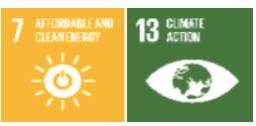
On 23 September, 2021, ENN Energy published its Decarbonisation Action 2030 – Journey to Net Zero to demonstrate its ambitions and efforts made to achieve carbon neutrality by 2050.
The report is our first decarbonisation action report. On the way stepping towards net-zero, we will periodically review factors such as the development of low-carbon related sections, changes of the market, corporate business planning, etc. to re-evaluate effectiveness and applicability of decarbonisation action, timely update the action and disclose to the society.
Net-zero Emission Roadmap
Our net-zero emission roadmap reaffirms the company's priority of achieving net-zero emission. Without relying on purchased carbon offsets, we are dedicated to reducing and naturalising carbon emissions with this action plan.
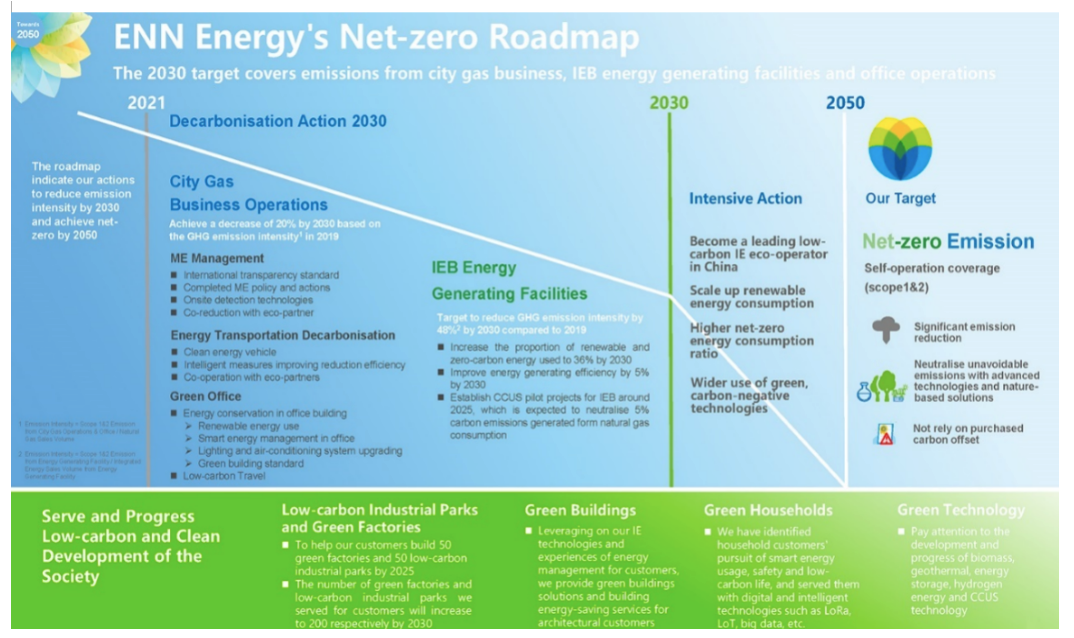
Decarbonisation Action 2030
The Decarbonisation Action 2030, which covers Scope I and II emissions of our city gas business, energy generating facilities of the integrated energy business (IEB), and office area, has decided the our meddle-term targets for carbon emission reduction, aiming to promote the own progress of net zero emissions, while serving the society to make clean and low-carbon development.
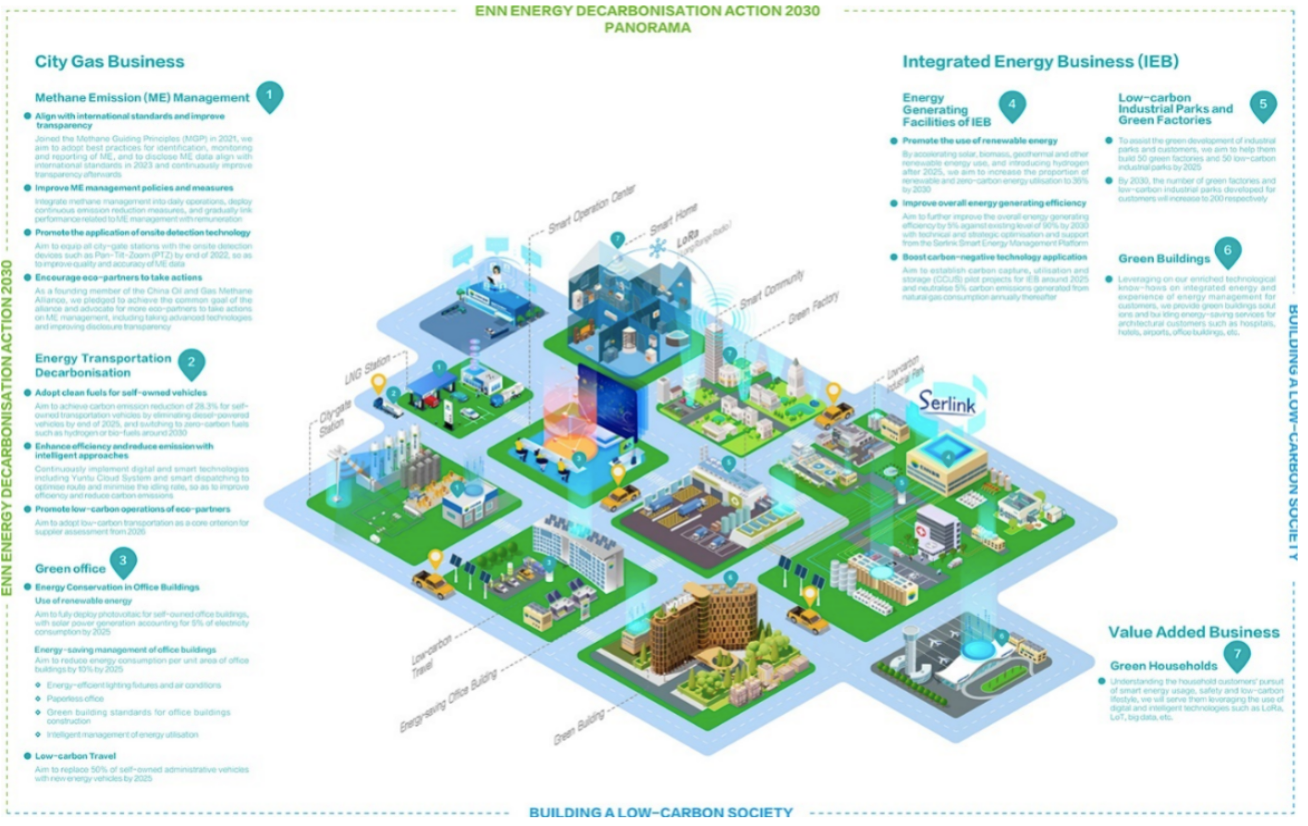
The 2030 Action Target
City Gas Business | |
Emission Reduction Target | · Reducing greenhouse gas emission intensity (scope1&2 greenhouse gas emissions/gas sold) by 20%, comparing to the intensity in 2019. |
Action | · Integrating methane management as part of emission reduction action scheme, disclosing methane emission data in 2023 with greater transparency, and engaging more eco-partners to mitigate methane emission. · Replacing existing oil-fueled energy transportation vehicles with clean fuel vehicles and progress zero-carbon energy in the future. · Promoting Pan-Tilt-Zoom laser methane monitoring system to cover all city gas stations by the end of 2022. · Establishing the pipeline integrity management system and the dynamic preventive operation management model. |
Integrated Energy Business | |
Emission Reduction Target | · Reducing the carbon emission intensity per unit of energy generated (Scope I and II greenhouse gas emissions/energy sold by energy generating facilities of IEB) by 48% from the energy generating facilities of IEB, compared to the 2019 baseline. |
Action | · Facilitating use of solar energy, biomass energy, geothermal energy, hydron and other renewable and zero-carbon energy, and increasing the proportion of renewable energy in the energy mix to 36% by 2030. · Improving the digitalisation capability of the Serlink Smart Energy Management Platform to increase energy efficiency of energy generating facilities by 5% on top of existing level of 90% by 2030 · ablishing CCUS pilot project by 2025, followed by gradually deploying CCUS technology in the energy generating facilities of IEB to offset 5% of carbon emissions from natural gas consumption |
Green Office | |
Action | · Increasing the share of solar power generation to 5% of our electricity consumption in 5 years while decreasing energy consumption per unit area of office buildings by 10%. · Replacing 50% of administrative vehicles with new energy vehicles by 2025. |
Green Transformation of Society | |
Action | · Providing low-carbon integrated energy, and intelligent energy system services which are adaptive to local conditions, energy-efficient, renewable energy-prioritised, and energy-complementary. We will serve industrial customers to build 50 green factories and 50 low-carbon industrial parks by the end of 2025, and enlarge the number to 200 by the end of 2030. · Relying on technologies and management experiences, we will provide strategy building design and energy-saving solutions and services for public construction customers (hospital, hotel, airports, office building, etc.). · Serving residential customers with intelligent, safe, low-carbon household services by long-range radio (LoRa), IoT and big data incorporation. |
Green Technology Application | |
Action | · Closely tracking green technologies related to biomass energy, geothermal energy, energy storage, hydron energy and CCUS. We will introduce these technologies into business appropriately by demonstrating pilot technologies and application projects. |
ENN Energy understands the importance of biodiversity conservation and habitat conservation to the environment. We have now issued the Biodiversity Protection Policy to regulate assessments of biodiversity impacts in day-to-day operations and to implement relevant ecological restoration initiatives. At the same time, the policy also stipulates that ENN Energy should fully respect residents and reduce community impact.
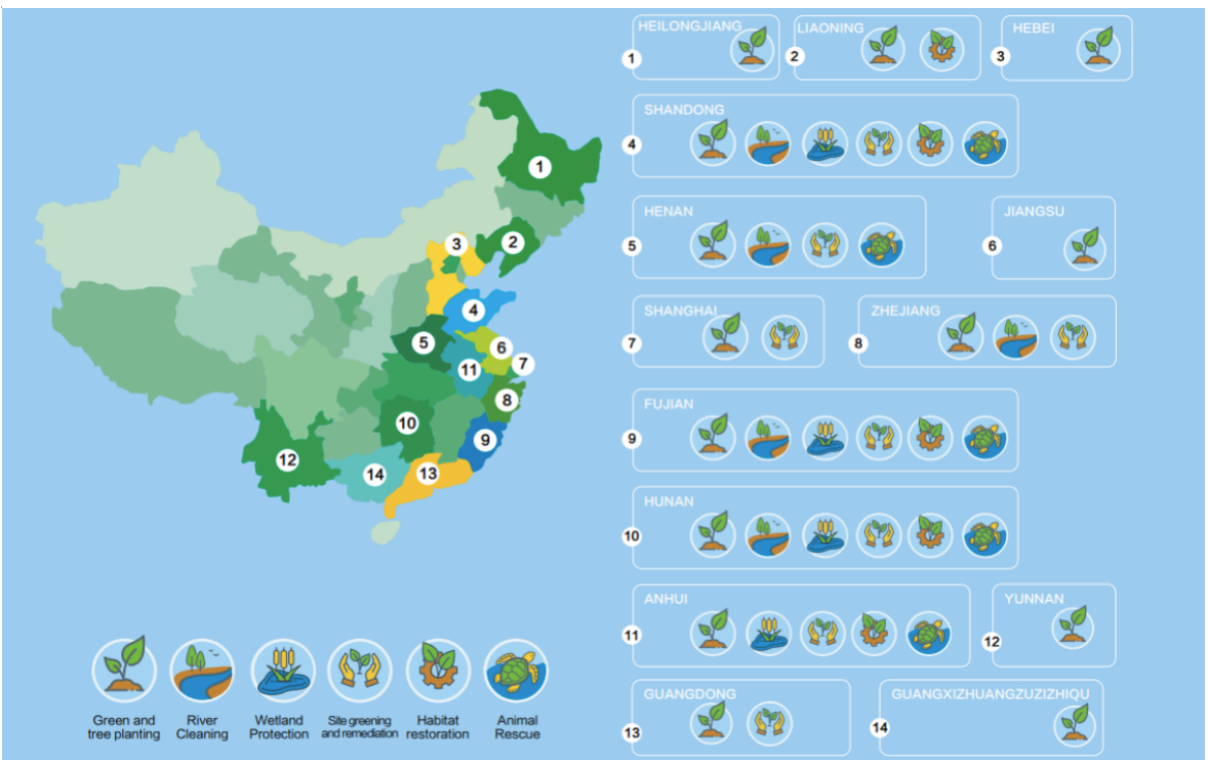
ENN Energy’s biodiversity action map
Conservation of Construction
To standardise environmental management of construction, thus mitigating impacts to the environment, following principles were launched for large-scale projects processing:
Green Construction | |
Pre-construction | · Conducting environmental impact assessments, safety assessments, occupational health assessments and set strict evaluation standards for ecological conservation zone. · Prohibiting construction in nature reserves, ecological function area, forest, dense forest area. |
During Construction | · During the construction, low-noise equipment shall be selected to reduce the sound source level. · Preventing disturbances on trees, vegetation, or animal habitats. · Disposing wastes in accordance with laws and regulations to prevent environmental hazards. |
Post-construction | · Restoring the original site to its original state over time and prevent additional damage to the environment as a result of delayed restoration |
Biodiversity Welfare
ENN Energy actively participates in biodiversity conservation public welfare related to biodiversity conservation, and carries out diversified environmental protection actions on environmental protection theme days such as "World Environment Day". At the same time, we support environmental protection, biodiversity conservation and ecological restoration projects, will organise employees from departments and subsidiaries to participate in environmental protection public welfare activities.
Biodiversity Conservation Gallery

ENN Energy donated funds to support Noah's Ark for building the Naban River Nature Education Base and improving the environmental protection practitioners' capacity

ENN Chuzhou actively participates in wildlife conservation public events

Slope rehabilitation and biodiversity protection at Longyan ENN Gaobei Station

ENN Yueyang participates in the protection of swan habitat in Donggu Lake Wetland

Revegetation of LNG storage and distribution station on Zhanjiang Donghai Island


Implementing methane emission management is an important environmental protection measure in ENN Energy's city gas business segment. We are particularly concerned about safety issues and greenhouse gas emissions caused by methane leakage and release, and continue to carry out technical transformation, upgrade and BOG recovery for gas transmission, distribution and storage processes.
Emission Source Identification
In 2021, we organized a team of experts to identify methane emission sources and emission causes in the main business scenarios of urban gas, and implement methane emission management measures in all aspects to ensure that important potential methane emission sources are included in the management process.
Methane Emissions Management
ENN Energy has now standardized internal systems, standards and procedures related to methane emission reduction. Through the use of digital and intelligent tools, we realized the closed-loop management of "planning-execution-checking-processing" of the operation process, and implement specific measures for methane emission control. At the same time, we enhanced the training of employees' skills, and gradually establish a performance appraisal and salary incentive mechanism for methane emission reduction.
Scenario | Management Initiatives |
Urban station, storage and distribution station, gas station | Strengthen the operation and management of plants and stations, avoid unplanned maintenance, improve the reliability of equipment and facilities, and reduce methane emissions in the operation process: o Use digital and intelligent solutions to improve plant and station operation and plan management. o Improve employee skills through technical competitions, I-craftsmanship projects, and skill training to ensure operational efficiency and quality. • Technology application, improve operation quality and efficiency, ensure safe operation, and reduce methane emission risk. o Use the filling crane arm and interlocking device to replace the unloading hose to ensure the safety of the operation, strengthen the operation and operation management of the plant, avoid unplanned maintenance, improve the reliability of equipment and facilities, and reduce methane emissions in the operation process; use digital and intelligent solutions to improve plant operation and plan management, improve employee skills through technical competitions, I-craftsman projects, skills training, etc., ensure operation efficiency and quality technology application, improve operation quality and efficiency, ensure safe operation, and reduce methane emissions risk; use the filling crane arm and the interlocking device to replace the unloading hose to ensure the safety of the operation. Real-time monitoring of the methane emission of the plant and station by using the laser methane gimbal to ensure the safe operation of the station area.
|
Pipe network and supporting facilities | • Carry out inspection of the old pipeline network of urban gas enterprises. • Strengthen the application of industrial IoT technology and pipe network simulation technology: o Use IoT equipment such as pressure regulating facility monitoring, valve wells, valve chambers, and cathodic protection to monitor the operation of the pipeline network and ancillary facilities. o Using online simulation technology, it is possible to dynamically simulate and calculate the operating conditions of the pipeline network, analyze the deviation from the actual operation, and automatically alarm to remind the operator that there may be faults and leaks, so as to assist in monitoring the actual pipeline network operation and identify and prompt hidden faults. • Using advanced methane monitoring instruments, gas leakage laser inspection vehicles, etc. to improve inspection efficiency, and quickly and accurately determine the potential safety threats of pipelines. • Promote the comprehensive coverage and application of the pipeline network visualization system, and realize the closed-loop management of the operation process "planning-executing-checking-processing". • Establish a pipeline integrity management system, build a dynamic preventive operation management model, and ensure pipeline safety.
|
Indoor | • Strengthen indoor security check to ensure the safety of users' gas consumption. • Strengthen the education on safe gas use. • Utilize the linkage between the internal alarm and the shut-off valve to prevent leakage accidents.
|
Vehicle transportation | • Promoting the installation of residual pressure recovery devices in liquid plants and receiving stations to reduce gas residues in loading and unloading, and reduce direct discharge of residual pressure. • Strengthen the maintenance and update of old vehicles and equipment, and install tank pressure detection equipment. • Continuously optimize dispatching plans through digital and intelligent means, improve vehicle operation efficiency, and optimize transportation routes and mileage. • Improve the safety management ability and safety operation standard of transportation links, and strengthen the training of employees. Make defensive driving training mandatory in carrier admission standards by the end of 2023. |
Benchmarking Industry and International leadership
Became a founding member of China Oil and Gas Company Methane Emission Control Alliance
In 2021, ENN Energy, as one of the founding members, joined the Methane Emission Control Alliance of Chinese Oil and Gas Companies. The alliance is a national, non-profit organization voluntarily initiated by companies engaged in oil and gas exploration, storage, transportation, and sales in China.
The alliance aims to promote the improvement of methane emission control technology and management level of oil and gas companies through sharing and cooperation among members, and support the country to achieve carbon peaking and carbon neutrality goals.
Join the Methane Guiding Principle (MGP)
The Methane Guiding Principle, established in 2019, is an international leading methane emission control organization. It aims to continuously reduce methane emissions, improve the level of methane control in the natural gas supply chain, improve data, advocate methane emission control policies and increase transparency. International large oil and gas companies including BP, Enagas, Shell are all members of the organization.
In 2021, ENN Energy became the second Chinese company to join the organization. We hope to take this opportunity to benchmark and learn from the excellent experience of international methane emission control, learn from excellent emission control measures, and further improve our performance in methane emission control.

Highlights of Methane Emission Control
On October 15, 2021, jointly organized by ENN Energy Holdings Co., Ltd., Beijing Gas Group Co., Ltd., and the Beijing Representative Office of the American Environmental Protection Association, the "11th China Gas Operation and Safety Seminar" and the " 2021 Academic Annual Meeting of the Gas Branch of the Chinese Society of Civil Engineering - Methane Emission Reduction to Help Urban Gas Carbon Neutralization Seminar" were held in Zhengzhou, Henan.
The "Methane Emission Control Initiative of China's Urban Gas Companies " initiated by ENN Energy and Beijing Gas has received positive responses from ten urban gas companies, and jointly signed the "Methane Emission Control Initiative of Chinese Urban Gas Companies". Liu Jianfeng, Chief Financial Officer of ENN Energy, attended the meeting as a guest speaker and presided over the signing ceremony.

